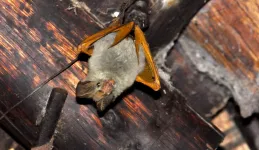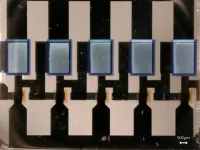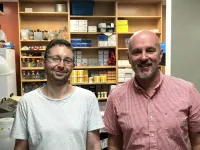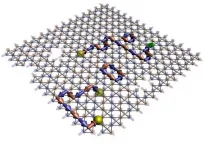When mad AIOLOS drags IKAROS down: A novel pathogenic mechanism
2021-07-16
(Press-News.org) Tokyo, Japan - Primary immunodeficiencies, such as severe combined immunodeficiency disease (SCID), occur when the immune system does not work properly, leading to increased susceptibility to various infections, autoimmunity, and cancers. Most of these are inherited and have an underlying genetic causes. A team at TMDU has identified a novel disorder resulting from a mutation in a protein called AIOLOS, which functions through a previously unknown pathogenic mechanism called heterodimeric interference.
The gene family known as IKAROS zinc finger proteins (IKZFs) is associated with the development of lymphocyte, a type of white blood cell involved in the immune response--meaning that mutations in this family can be involved in immune system deficiencies. Most research so far has focused on IKAROS protein, encoded by the gene IKZF1, although the underlying mechanism by which IKAROS mutations cause the deficiencies is not yet fully understood. A mutation in AIOLOS--another member of the IKZF family that is encoded by the gene IKZF3--has now also been revealed to cause a hereditary immune deficiency. In addition to not functioning properly itself, the resultant mutant protein interferes with the functioning of IKAROS protein.
TMDU researchers uncovered this new mechanism while investigating the cause of a previously undescribed inherited B cell deficiency observed in a family of patients. After sequencing all of the protein-coding genes, the team focused their research on AIOLOS as IKAROS is known to be the cause of B cell deficiency. They showed that the mutant form of AIOLOS that was present in this family did not just fail to function, but actively bound to a different DNA sequence than the normal version of the protein.
They went on to use a mouse model that harbors equivalent AIOLOS mutation identified in the patients to outline the underlying pathogenic mechanism. AIOLOS and IKAROS bind together to form a "heterodimer". The mutant form of AIOLOS retained the ability to bind IKAROS but then interfered with the normal function of IKAROS, and led to the heterodimer being recruited to the incorrect regions of the genome.
"This is a novel pathogenic mechanism that we termed heterodimeric interference," says lead author Motoi Yamashita, "where a mutant protein in a heterodimer hijacks the function of the normal partner protein."
The team were then able to rescue some of the immune function in the mouse model by deleting the dimerization domain of the mutant AIOLOS.
"The fact we could rescue the phenotype in our mouse model indicates a potential therapeutic approach," says Tomohiro Morio, senior author. "The deletion of the domain responsible for binding IKAROS in the mutant AIOLOS protein could ameliorate the immunodeficiency observed in the patients."
The discovery of this new pathogenic mechanism, heterodimeric interference, may well help to shed light on many other disease processes such as autoimmunity and cancer development where mutant proteins act in the same way.
INFORMATION:
The article, "A Variant in Human AIOLOS Impairs Adaptive Immunity by Interfering with IKAROS", was published in Nature Immunology at DOI: 10.1038/s41590-021-00951-z.
[Attachments] See images for this press release:

ELSE PRESS RELEASES FROM THIS DATE:
2021-07-16
URBANA, Ill. - U.S. corn and soybean varieties have become increasingly heat and drought resistant as agricultural production adapts to a changing climate. But the focus on developing crops for extreme conditions has negatively affected performance under normal weather patterns, a University of Illinois study shows.
"Since the 1950s, advances in breeding and management practices have made corn and soybean more resilient to extreme heat and drought. However, there is a cost for it. Crop productivity with respect to the normal temperature and precipitation is getting lower," says Chengzheng Yu, doctoral student in the Department ...
2021-07-16
New research led by the University of Cambridge suggests that autism can be detected at 18-30 months using the Quantitative Checklist for Autism in Toddlers (Q-CHAT), but it is not possible to identify every child at a young age who will later be diagnosed as autistic. The results are published today in The BMJ Paediatrics Open.
The team at the Autism Research Centre in Cambridge conducted a prospective population screening study of nearly 4,000 toddlers using a parent-report instrument they developed, called the Quantitative Checklist for Autism in Toddlers (Q-CHAT). Toddlers were screened at 18 months and followed up at 4 years.
The ...
2021-07-16
Northwestern University engineers have developed the first full, three-dimensional (3D), dynamic simulation of a rat's complete whisker system, offering rare, realistic insight into how rats obtain tactile information.
Called WHISKiT, the new model incorporates 60 individual whiskers, which are each anatomically, spatially and geometrically correct. The technology could help researchers predict how whiskers activate different sensory cells to influence which signals are sent to the brain as well as provide new insights into the mysterious nature of human touch.
The research was published last week in the Proceedings ...
2021-07-16
Bat conversations might be light on substance, according to researchers from the University of Cincinnati.
Echoes from bats are so simple that a sound file of their calls can be compressed 90% without losing much information, according to a study published in the journal PLOS Computational Biology.
The study demonstrates how bats have evolved to rely on redundancy in their navigational "language" to help them stay oriented in their complex three-dimensional world.
"If you can make decisions with little information, everything becomes simpler. That's nice because you don't need a lot of complex neural machinery to process and store that information," study co-author Dieter Vanderelst ...
2021-07-16
Physicists of the Technische Universität Dresden introduce the first implementation of a complementary vertical organic transistor technology, which is able to operate at low voltage, with adjustable inverter properties, and a fall and rise time demonstrated in inverter and ring-oscillator circuits of less than 10 nanoseconds, respectively. With this new technology they are just a stone's throw away from the commercialization of efficient, flexible and printable electronics of the future. Their groundbreaking findings are published in the renowned journal "Nature Electronics".
Poor performance is still impeding the commercialization ...
2021-07-16
Researchers at Vanderbilt University Medical Center (VUMC) and the Baylor College of Medicine in Houston, Texas, have taken a big step toward developing targeted treatments and vaccines against a family of viruses that attacks the gastrointestinal tract.
Each year in the United States circulating strains of the human norovirus are responsible for approximately 20 million cases of acute gastroenteritis. Hallmark symptoms include severe abdominal cramping, diarrhea and vomiting.
Several vaccine candidates are in clinical trials, but it is unclear how effective they will be, given the periodic emergence of novel norovirus variants. Developing ...
2021-07-16
All cancers fall into just two categories, according to new research from scientists at Sinai Health, in findings that could provide a new strategy for treating the most aggressive and untreatable forms of the disease.
In new research out this month in Cancer Cell, scientists at the Lunenfeld-Tanenbaum Research Institute (LTRI), part of Sinai Health, divide all cancers into two groups, based on the presence or absence of a protein called the Yes-associated protein, or YAP.
Rod Bremner, senior scientist at the LTRI, said they have determined that all cancers ...
2021-07-16
WHAT:
A new study published in Nature Communications suggests that gene therapy delivered into the brain may be safe and effective in treating aromatic L-amino acid decarboxylase (AADC) deficiency. AADC deficiency is a rare neurological disorder that develops in infancy and leads to near absent levels of certain brain chemicals, serotonin and dopamine, that are critical for movement, behavior, and sleep. Children with the disorder have severe developmental, mood dysfunction including irritability, and motor disabilities including problems with talking ...
2021-07-16
LOS ALAMOS, N.M., July 15, 2021-- Using a D-Wave quantum-annealing computer as a testbed, scientists at Los Alamos National Laboratory have shown that it is possible to isolate so-called emergent magnetic monopoles, a class of quasiparticles, creating a new approach to developing "materials by design."
"We wanted to study emergent magnetic monopoles by exploiting the collective dynamics of qubits," said Cristiano Nisoli, a lead Los Alamos author of the study. "Magnetic monopoles, as elementary particles with only one magnetic pole, have been hypothesized by many, and famously by Dirac, but have proved elusive so far."
They realized an artificial spin ice by using the superconducting qubits of the quantum machine as a magnetic building block. Generating magnetic materials ...
2021-07-16
Great leaps in science and technology have been propelled by recent advances in seeing fast evolving physical phenomena, as they happen. Femtosecond lasers from the infrared to the X-ray region have enabled us to 'watch', in real time, atoms dance in molecules and solids on femtosecond and picosecond timescales. Watching such fascinating motions not just in real time but at the spatial locations where they happen, is a bigger challenge.
It is precisely this advance that has been made by a team of researchers at the Tata Institute of Fundamental Research, Mumbai, York University and the Rutherford Appleton Laboratories, UK [1]. They exploded a solid surface with an ultrahigh ...
LAST 30 PRESS RELEASES:
[Press-News.org] When mad AIOLOS drags IKAROS down: A novel pathogenic mechanism






